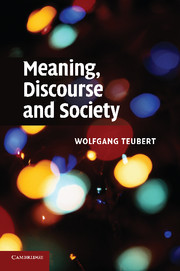Book contents
- Frontmatter
- Contents
- Acknowledgements
- Introduction
- Part I Meaning, the mind and the brain
- Part II Discourse and society
- 8 Language as discourse
- 9 Society presupposes language, and language presupposes society
- 10 A closer look at oral societies
- 11 Differences between oral and literate societies
- 12 Empirical linguistics deals only with recorded language
- 13 Meaning, knowledge and the construction of reality
- 14 The language of the scientific experimental report
- 15 Diachronicity, intertextuality and hermeneutics
- 16 Meaning and the interpretation of a haiku
- Conclusion
- Bibliography
- Index
16 - Meaning and the interpretation of a haiku
Published online by Cambridge University Press: 04 August 2010
- Frontmatter
- Contents
- Acknowledgements
- Introduction
- Part I Meaning, the mind and the brain
- Part II Discourse and society
- 8 Language as discourse
- 9 Society presupposes language, and language presupposes society
- 10 A closer look at oral societies
- 11 Differences between oral and literate societies
- 12 Empirical linguistics deals only with recorded language
- 13 Meaning, knowledge and the construction of reality
- 14 The language of the scientific experimental report
- 15 Diachronicity, intertextuality and hermeneutics
- 16 Meaning and the interpretation of a haiku
- Conclusion
- Bibliography
- Index
Summary
In this chapter, I want to show how we can work together to negotiate the meaning of a text. What I present is not a methodology, not a manual for interpretation that delivers a result quasi-automatically by going through the process step by step. What I want to show is that while interpretation is an activity with an unpredictable outcome, for those who collaborate there is one reality on which they can base their negotiations: the reality of the text embedded in the reality of the discourse. This is the reality available to all those concerned in the interpretation. This is the common basis. I have purposefully chosen a text that is rather removed from our ordinary life-world, this very unassuming haiku:
abrasive heron
blares, blue jittery songbirds
stampede bouncily
This is a haiku of little if any poetic value. But that is not the point. What I am interested in is what it means. As with any new contribution to the discourse, the only way to make sense of it is to look at it as a reaction to what has been said before. If we were to take it as a text that has not emerged out of the discourse we could never assign an interpretation to it. We would still see all those words looking so familiar, but we could not be sure what they mean. It would be a text constructed on Humpty Dumpty principles.
- Type
- Chapter
- Information
- Meaning, Discourse and Society , pp. 215 - 240Publisher: Cambridge University PressPrint publication year: 2010

